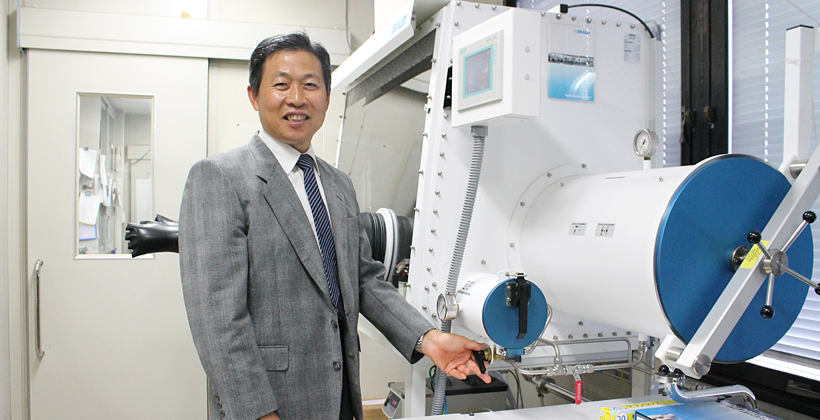HOME > List of Voice of grantees > Creation of an Innovative Organic Hetero Atom Functional Material
Creation of an Innovative Organic Hetero Atom Functional Material"Creation of Industrial Infrastructure" 2nd Grant Period: April 2011–March 2014
Details of research conducted during the grant period
Development of a catalytic process for industrial production of functional phosphorus compounds; development of new manufacturing methods and commercialization
Generally, the term "organic compound" refers to carbon-hydrogen compounds, but the materials I studied early on, and continued to research, are organic phosphorus and organic sulfur compounds. Phosphorus compounds meet a number of industrial applications, and I have come to understand manufacturers' requests for commercialization of some of them. The National Institute of Advanced Industrial Science and Technology, where I'm currently working, had emphasized the importance of research leading to practical applications. This is an avenue worth pursuing. However, developing a product from our basic research is an extremely difficult challenge. I proceeded with the initial research with JST's grant for science/research and NEDO's grant, but the research was stopped at the basic stage. When I encountered difficulty meeting the final goal of commercialization, I applied for a grant from the Canon Foundation and my application was accepted.

During the grant period, I succeeded in developing a catalyst for production of vinyl phosphorus*1 that maintains stability at low cost, which was a tremendous result. Furthermore, I developed a catalyst creation process for industrial commercialization and was able to meet the final goal. The Canon Foundation's grant was the final push that enabled me to reach the commercialization stage.
For example, in my field of study, basic research is considered mostly complete once a new reaction is found. However, this was a rare case in which my basic research developed to the product stage, and I'm immensely pleased with this success. I think the results of research should be put in the hands of people as much as possible, and these results should be developed into a product as a final goal if manufacturers express demand. This approach might result in benefits.
- *1
- Vinyl phosphorus: an olefin compound containing a phosphorus molecule that is free from chlorine, which generates dioxin
Why did you focus on phosphorus first?
Phosphorus is an indispensable element for all plants and animals. An adult's body is said to contain about 500 grams of phosphorus. Phosphorus compounds are well known as ingredients in insecticides and herbicides. (We have a negative impression of such toxic substances). In reality, however, phosphorus compounds are widely used in medicines such as antibiotics and hepatitis remedies. At least 16 researchers have won Nobel Prizes for their research on phosphorus. Phosphorus compounds have a great deal of potential.
On the other hand, the method for producing phosphorus compounds has several challenges. Despite their wide range of application, they cannot be made efficiently. Few researchers have conducted research on this issue. In the National Institute of Advanced Industrial Science and Technology, only our team has been engaged in this research. The methods used for organic phosphorus synthesis have scarcely progressed for more than 100 years. On the other hand, the scope of application for organic phosphorus has expanded dramatically. I thought it intuitive that, if phosphorus compounds could be efficiently and easily created, further innovative applications might emerge. This was my inspiration for pursuing this research. At that time, the steps I took were intuitive, but I was able to achieve my goal in the end.
What applications have been developed for vinyl phosphorus compounds?
Because of their flame retardant characteristics, these are used mainly as flame-retardants.
Flame retardancy is a major characteristic of phosphorus. It has a powerful application as a flame-retardant. Vinyl phosphorus also has this property. Macromolecules containing a small amount of vinyl phosphorus become flame-retardant. Even electric appliances such as Canon copying machines contain flame-retardants. Until recently, halogen compounds*2 had been used as flame-retardants.

However, some of them gradually decompose into toxic substances, or may generate dioxins during combustion. Therefore, in European countries and elsewhere, halogen compounds have been prohibited. Consequently, the flame retardants used in electric appliances need to be changed. Thus, demand for phosphorus-based flame retardants has been increasing, and the vinyl phosphorus that I developed is also attracting much interest.
- *2
- Halogen compounds: organic compounds containing chlorine and bromine, which have been widely used as flame retardants.
Progress and developments following the research funding period
Research into phosphorus chemistry has only just begun. We have much to do in terms of basic research and research for commercialization. We intend to continue with our best efforts to achieve commercialization.
Our first goal is to develop a new manufacturing process by expanding our basic research in order to supply a new phosphorus product for the real world.
Our second goal is to consider phosphorus in a comprehensive manner, including the recycling of phosphorus.
Because of the huge volume of work we are facing, it is clear that we need many more researchers to participate in this project. This is too difficult a challenge for me to undertake by myself. Actually, to my regret, the number of researchers who study phosphorus is quite low. I think that the first issue I should focus on is to increase the number of phosphorus researchers.
Phosphorus is also indispensable as an important ingredient of the fertilizers used to grow crops. Japan relies heavily on imports from other countries in this regard. Some believe that our phosphorus resources will be depleted in several dozen years. If phosphorus reserves become depleted, we will not be able to build functional materials or grow crops. So, we need to consider phosphorus from a strategic perspective. I urgently wish that this issue be addressed comprehensively at a national level without delay. This could entail collaboration between industry, academia, and government with a focus on advanced phosphorus collection technology, advanced phosphorus manufacturing technology, and advanced phosphorus application technology, which includes phosphorus-saving technology. If these technologies were established, sufficient supplies of phosphorus could be secured within Japan, erasing our reliance on imports. What's more, I expect that we could even export phosphorus in the form of highly functional products, resulting in considerable economic benefits. These proposals are gaining somewhat more acceptance than they have had before.
What made you want to become a researcher?

Early on, I liked to experiment. I used to stay up all night doing experiments. I'm still actively engaged in benchwork with flasks. I just happened to become involved in the field of chemistry. At the start of my career as a professional researcher, I followed my professor in conducting research on tellurium at university. My professor frequently advised me to study unique subjects and to avoid imitating others. That has become my motto, and I've stuck to it. Thanks to this advice, I have pursued most of my work in my own style; in other words, my research is original.
Finally, what are your dreams for the future?
Innovation with Phosphorus – Realizing the Promise of the New Industry of the Future
Considering the initiative to devise more applications for phosphorus, innovation with phosphorus is the key.
I think that phosphorus is a research subject that should be comprehensively studied as a national project, and finally as a strategic substance. I'm working hard to realize such a project. Phosphorus has been used in most fields of endeavor, but generally it does not play a principal role, so it isn't given much attention. For example, phosphorus is present in most batteries used in electric vehicles, which are likely to be a huge focus of development going forward. What's more, it is also closely related to food. I intend to take an active role in publicizing this initiative, in addition to our main job of conducting research, by being persistent in explaining these applications to those concerned.
Phosphorus has a wide range of applications linked to almost all industries, and its potential continues to expand more and more. In particular, the development of new industries holds much promise for the future.

Profile
Li-Biao Han
National Research and Development Agency, National Institute of Advanced Industrial Science and Technology
Team leader of Heteroatom Chemistry Team, Interdisciplinary Research Center for Catalytic Chemistry (Doctor of Engineering)






